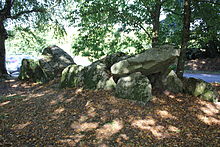Megalithic systems from Kergonfalz
The megalithic complex of Kergonfalz consists of a dolmen and an allée couverte , which are about 70 m apart, north and south of a road, west of Bignan in the Morbihan department in Brittany in France . Knickdolmen are known in only seven copies ( Dolmen von Goërem ), all of which are about 100 km in length between the mouths of the Loire (near Saint-Nazaire ) and the Blavet (near Lorient ) and around 3000 BC. Were created.
The systems date to the Neolithic , around 3000-2700 BC. In France, dolmen is the generic term for megalithic structures of all kinds (see: French nomenclature ).
Dolmen
The approximately northwest-southeast oriented dolmen is a "dolmen à coudé" (elbow or buckled dolmen). It's called "le trou des Chouans" (because it served as a hiding place for the Chouannerie ). It lies in the middle of the Kergon fold tumulus . The round hill has a diameter of 25 to 30 m and is up to five meters high. The rectangular chamber measures approximately 3.0 x 2.0 m and is covered by a single capstone. The four-meter-long entrance to the chamber is severely disturbed and is located in the bend in the east, like the Dolmen du Kernourz in Bono .
Human remains, diorite axes, urns, flint and pottery have been found in the Vannes Museum.
Location: 47 ° 52 ′ 40.8 ″ N , 2 ° 47 ′ 40.2 ″ W.
Gallery grave
The "Allée couverte de Lescadec" is about 9.5 meters long and 1.5 m wide and oriented to the south. In the north there is a closure plate and a small antechamber. A bearing stone has been lost; 12 are preserved. Three cap stones are still there, but partially or completely overturned.
Location: 47 ° 52 ′ 40.1 ″ N , 2 ° 47 ′ 37 ″ W.
See also
literature
- Jacques Briard : The Megaliths of Brittany. Éditions Jean-Paul Gisserot, Paris 2000, ISBN 2-87747-065-2 .
Web links
Individual evidence
- ↑ Ker is a Breton appellative that is often used as a prefix for place names. It means: "inhabited place".

